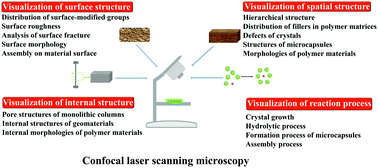Visualization of materials using the confocal laser scanning microscopy technique
Abstract
The development of materials science always benefits from advanced characterizations. Currently, imaging techniques are of great technological importance in both fundamental and applied research on materials. In comparison to conventional visualization methods, confocal laser scanning microscopy (CLSM) is non-invasive, with macroscale and high-contrast scanning, a simple and fast sample preparation procedure as well as easy operation. In addition, CLSM allows rapid acquisition of longitudinal and cross-sectional images at any position in a material. Therefore, the CLSM-based visualization technique could provide direct and model-independent insight into material characterizations. This review summarizes the recent applications of CLSM in materials science. The current CLSM approaches for the visualization of surface structures, internal structures, spatial structures and reaction processes are discussed in detail. Finally, we provide our thoughts and predictions on the future development of CLSM in materials science. The purpose of this review is to guide researchers to build a suitable CLSM approach for material characterizations, and to open viable opportunities and inspirations for the development of new strategies aiming at the preparation of advanced materials. We hope that this review will be useful for a wide range of research communities of materials science, chemistry, and engineering.



 Please wait while we load your content...
Please wait while we load your content...